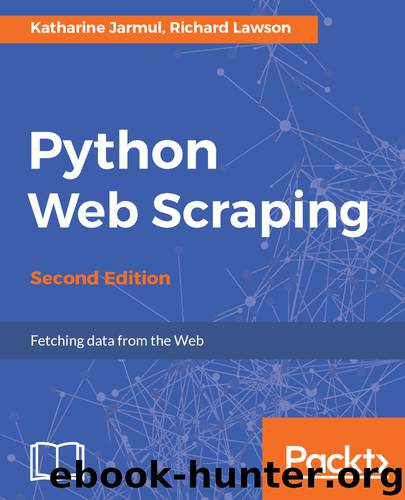Python Web Scraping by Katharine Jarmul

Author:Katharine Jarmul
Language: eng
Format: epub
Publisher: Packt Publishing
Published: 2017-05-29T09:14:54+00:00
def process_queue():
while len(crawl_queue):
url = crawl_queue.pop()
...
The first change is replacing our Python list with the new Redis-based queue, named RedisQueue. This queue handles duplicate URLs internally, so the seen variable is no longer required. Finally, the RedisQueue len method is called to determine if there are still URLs in the queue. Further logic changes to handle the depth and seen functionality are shown here:
## inside process_queue
if no_robots or rp.can_fetch(user_agent, url):
depth = crawl_queue.get_depth(url) or 0
if depth == max_depth:
print('Skipping %s due to depth' % url)
continue
html = D(url, num_retries=num_retries)
if not html:
continue
if scraper_callback:
links = scraper_callback(url, html) or []
else:
links = []
# filter for links matching our regular expression
for link in get_links(html, link_regex) + links:
if 'http' not in link:
link = clean_link(url, domain, link)
crawl_queue.push(link)
crawl_queue.set_depth(link, depth + 1)
The full code can be seen at http://github.com/kjam/wswp/blob/master/code/chp4/threaded_crawler_with_queue.py.
This updated version of the threaded crawler can then be started using multiple processes with this snippet:
import multiprocessing
Download
This site does not store any files on its server. We only index and link to content provided by other sites. Please contact the content providers to delete copyright contents if any and email us, we'll remove relevant links or contents immediately.
The Mikado Method by Ola Ellnestam Daniel Brolund(20556)
Hello! Python by Anthony Briggs(19862)
Secrets of the JavaScript Ninja by John Resig Bear Bibeault(18164)
The Well-Grounded Java Developer by Benjamin J. Evans Martijn Verburg(17538)
OCA Java SE 8 Programmer I Certification Guide by Mala Gupta(17390)
Kotlin in Action by Dmitry Jemerov(17137)
Algorithms of the Intelligent Web by Haralambos Marmanis;Dmitry Babenko(16199)
Grails in Action by Glen Smith Peter Ledbrook(15356)
Sass and Compass in Action by Wynn Netherland Nathan Weizenbaum Chris Eppstein Brandon Mathis(13239)
Test-Driven iOS Development with Swift 4 by Dominik Hauser(10380)
Windows APT Warfare by Sheng-Hao Ma(7832)
Layered Design for Ruby on Rails Applications by Vladimir Dementyev(7545)
Blueprints Visual Scripting for Unreal Engine 5 - Third Edition by Marcos Romero & Brenden Sewell(7447)
Solidity Programming Essentials by Ritesh Modi(4560)
Functional Programming in JavaScript by Mantyla Dan(4431)
Hands-On Full-Stack Web Development with GraphQL and React by Sebastian Grebe(4425)
WordPress Plugin Development Cookbook by Yannick Lefebvre(4378)
Unity 3D Game Development by Anthony Davis & Travis Baptiste & Russell Craig & Ryan Stunkel(4266)
The Ultimate iOS Interview Playbook by Avi Tsadok(4249)
